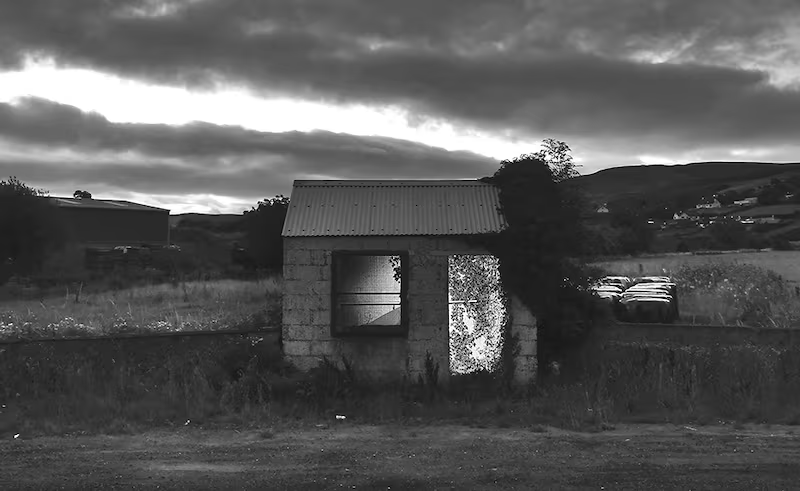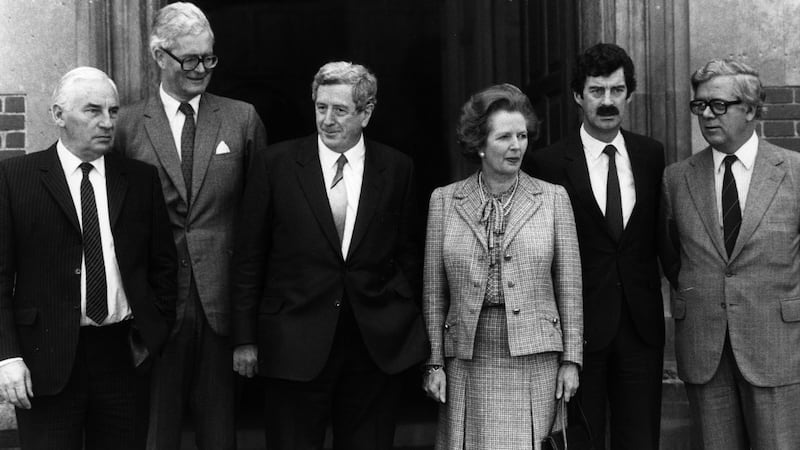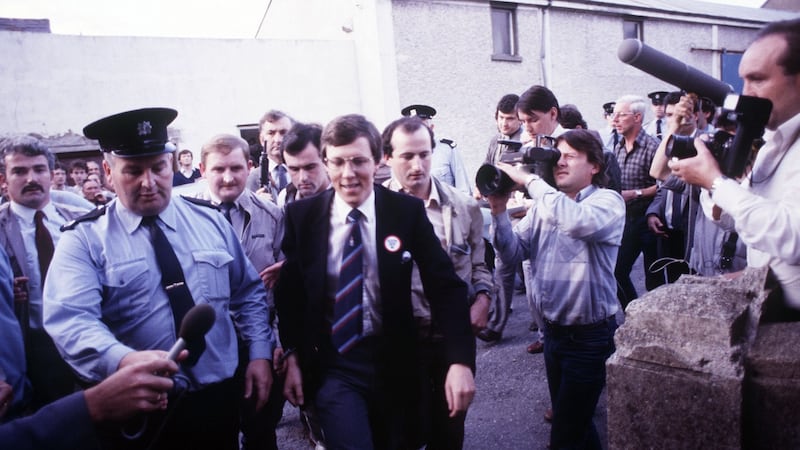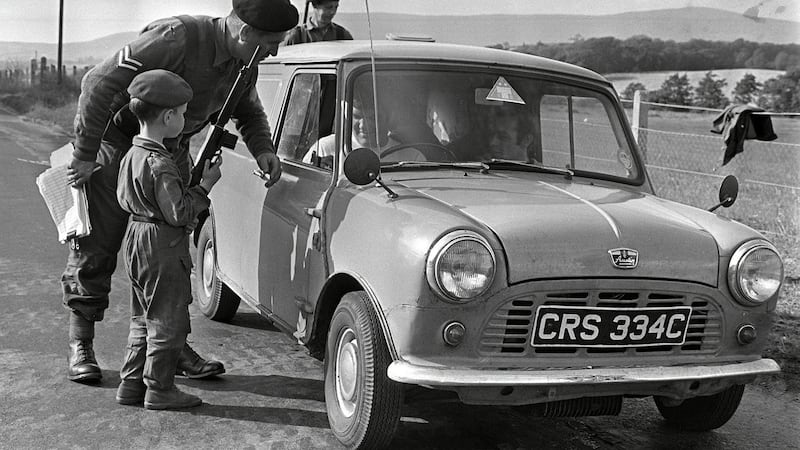In 1983, taoiseach Garret FitzGerald convened the New Ireland Forum in Dublin, intending to achieve a consensus among constitutional nationalist parties. John Hume had pushed for the forum against the grain of historic hostility to the idea of an all-Ireland forum to discuss the future of Northern Ireland.
It was partly, as he saw it, about preserving the SDLP’s relevance in the face of a potential Sinn Féin challenge (that party was emboldened by the hunger strikes and the resultant electoral dividend) by getting the Irish government to bring home to the British government the measure of its responsibility for the Northern Ireland crisis and forcing it to respond to concrete proposals.
It was also about attempting to formulate a more inclusive Irish “identity”.

The forum report committed nationalists to recognising the validity of both nationalist and unionist identities, and for them to be protected “in equally satisfactory, secure and durable, political, administrative and symbolic” form.
While the forum’s preferred solution was a “unitary state” it also underlined nationalists’ openness to proposals other than a united Ireland, including a federal/co-federal or joint authority solution.
However, British prime minister Margaret Thatcher made it clear in response that three constitutional options for Northern Ireland were "out"– a unified Ireland, a confederation system or joint authority.
Secret plan
Another thing that was ruled out in 1984 was the redrawing of the Border. A secret plan was discussed by the UK cabinet to place some predominantly Catholic areas of Northern Ireland in the Republic to “produce a more homogenous population in Northern Ireland”. However, it was ditched, with Northern Ireland secretary Jim Prior insisting it would only be considered “if we were faced with imminent civil war or as a result of civil war, but I do not believe we have reached that stage”.
Sir David Goodall, one of the diplomats negotiating with the Irish government, also recorded that late one night at Chequers Thatcher made the “outrageous” proposal that if the Northern Catholic population wanted to be in the South “well, why don’t they move over there?”
“After all, there was a big movement of population in Ireland, wasn’t there?” Goodall recalled.
“Nobody could think what it was. So finally I said, ‘you are talking about Cromwell?’ She said, ‘that’s right, Cromwell’.”
Once again Thatcher was betraying her ignorance of Irish history; Oliver Cromwell had been responsible for a bloody, sectarian conquest of Ireland in the mid-17th century, a period during which up to 30 per cent of the population may have perished.
Sir Charles Powell, Thatcher’s private secretary at this time, also suggested she wanted the Irish Border to be redrawn.
“She thought that if we had a straight line border, not one with all those kinks and wiggles in it, it would be easier to defend”, only to be told by Lord Armstrong, the cabinet secretary, of the folly of her thinking: ‘It wasn’t as simple as that because the nationalist communities were not all in one place’.”
Explosive charges
Nor was the idea of sealing the Border, mentioned as a “nuclear option” as early as 1973, remotely feasible. Writer Garret Carr has recorded that“while stationed on the Border one officer jotted down what it would take to seal the whole length; 303 miles of mesh fencing; a vehicle track along the entire length; a hinterland security fence; 360,000 explosive charges; 165 miles of vehicle hazards, such as ditches and steel spikes; a hundred pillboxes; a hundred concrete observation towers. The defence would also need command posts, bunkers, dogs, dog runs and thousands of arc lights. All of that before the boots on the ground are considered.”
Thatcher made one brief visit to the Border, and viewed it “from the window of a high-speed helicopter. She was gone in half an hour.”

The efforts of Hume and others in the US meant Thatcher was subsequently leaned on to relent in relation to the involvement of Irish governments in the affairs of Northern Ireland. FitzGerald subsequently undertook negotiations with the British government leading to the 1985 Anglo-Irish Agreement.
The agreement was described at the time as involving the British government inviting the Irish government “to share in the burden of administering the troubled province of Northern Ireland” and a “dramatic shift in prime minister Thatcher’s position…Never before has Britain acknowledged that Ireland has a legal role to play in governing the North.”
The Anglo-Irish Agreement, it was asserted at the time, “contradicts…the belief that the North is exclusive British territory, that its affairs are purely an internal British concern”.
With it “the two governments promised that the constitutional status of Northern Ireland could only be changed with the consent of the majority of the people there”.
But the reaction to the agreement also underlined, in the words of the deputy editor of the Belfast Telegraph, Barry White, that "Northern Ireland's Protestant unionists and Roman Catholic nationalists have never been further apart".
Fractiousness
Some of the political reminiscences about the 1980s underline the fractiousness and occasional wackiness of the thinking about the Border in the context of fraught Anglo-Irish exchanges.
Thatcher was no lover of Northern Ireland; after she and FitzGerald signed the Anglo-Irish Agreement and celebrated with a glass of champagne, FitzGerald raised the question of seeking support from the International Fund for Ireland, envisaged under the agreement to promote the social and economic development of areas in Ireland affected by the Troubles, which by the mid-1980s had resulted in the deaths of over 2,500 people.
“More money for these people?” Thatcher said, waving her hand in the general direction of Northern Ireland. “Look at their schools; look at their roads! Why should they have more money? I need that money for my people in England who don’t have anything like this.”
FitzGerald recalled that he “was frankly quite nonplussed at this singular declaration of English nationalism”.
In 1986, FitzGerald and Thatcher were attempting to hold the line on the Anglo-Irish Agreement in the teeth of visceral unionist opposition, and they met in December in London. Thatcher was blunt in how she assessed the Border security situation. “You haven’t the resources to maintain protection on the other side of the Border.”
Thatcher wanted helicopters on the Border with the right to fly five miles in either direction or what she called “a broad corridor around the Border”.
In response, FitzGerald praised the RUC for working in conjunction with the Garda on the issue, but concluded bluntly and bleakly: “Both forces have a next-to-impossible Border to watch.”
Thatcher responded intriguingly: “Yes, we got it wrong in 1921.”
FitzGerald also asserted “so many people from the North come down to the South and live there. We have 200 people from the North in our jails. You can have them back any time you want!”
Thatcher’s response was “I don’t want them. You can have all the nationalists in the North if you like!”
Invasion of Clontibret
The DUP was also determined to insist the Anglo-Irish Agreement had not improved Border security. In trying to make that point DUP deputy leader and MP Peter Robinson made a fool of himself and demonstrated his cowardice in August 1986 when he joined a loyalist mob for an "invasion" of Clontibret, one of several Border crossing points in north Monaghan that were targeted to supposedly demonstrate that the agreement had failed to produce better cross-Border security.
It turned violent and menacing; some of the loyalists wore paramilitary uniforms, carried cudgels and iron bars, daubed loyalist slogans and attacked gardaí, two of whom had to fire over their heads.

Robinson was arrested and charged, scoring a spectacular own goal; he had been caught “running away from the scene”. He faced initial charges of unlawful assembly, malicious damage and assault.
The case eventually came before the Special Criminal Court in Dublin where Robinson pleaded guilty and had to pay a fine of £17,500 (Irish pounds or punts; not the sterling used in Northern Ireland; he was then labelled “Peter the Punt” by some wags). Justice Barr condemned the loyalists’ “grossly offensive, provocative, cowardly and terrifying attack”.
In 1987, Willie Whitelaw, the first secretary of state for Northern Ireland and close to Thatcher, had a private conversation with Noel Dorr, the Irish ambassador in London. He expressed the view that if power-sharing in Northern Ireland could be successfully achieved "the importance of the Border would fade away over 50 years or so…then unity would be a real possibility".
Yet there was no sign of any thaw that would make that likely, and debate about the validity of Northern Ireland and the Border continued.
Catholic state
In 1989, Ulster-born economist Tom Wilson argued that Protestants had been more tolerant than their critics portrayed, but also that the ailing Republic did not have the wealth to replace British subvention to Northern Ireland, and was still too much of a Catholic state for a Catholic people to embrace Protestants.
He rejected the idea that majority determination should decide the status of the North; what was needed was fuller integration into the UK because Northern Ireland’s instability was fuelled by too much uncertainty about its status.
Whatever about the high politics that governed the Border and the diplomacy and papers that analysed it, what did it mean in the 1980s to those living on or near it?
During his tour of the Border region in 1986 for what became the 1987 book Walking Along the Border, journalist and novelist Colm Tóibín walked out of Derry and in half an hour was in the Republic where the price of petrol, alcohol, cars and televisions was much higher. "No one would dream of smuggling from the South to the North."

A number of things were striking about his journey, including the meandering complexity of the Border. To get to Castlederg in Co Tyrone, on the Border with Donegal, for example, he was warned by one guider “that I would go into the South, into the North, into the South again, and back into the North”.
“‘How will I know whether I’m in the North or South?’ I said to him.
“‘You won’t know,’ he replied, managing a gruff sort of smile.”
Those traversing its terrain were often alone, like Tóibín and later Garrett Carr, as recounted in The Rule of the Land: Walking Ireland's Border (2017). As he trails into the Cooley Mountains, Carr notes: "You need local knowledge or, like me, a detailed ordnance survey map to know which is the Border. I find an apple tree growing straight out of the line. A coincidence, I wonder, that the tree took root in the Border line, or did someone plant it there as a marker? There is no one to ask on these unpopulated slopes. I will not see a single person all morning."
‘Hidden country’
The nature of living in a Border area was also central to the work of novelist Eugene McCabe, whose house was right on the Border; the driveway of his farm crossed from Monaghan into Fermanagh and back again.
McCabe wrote of the Border counties as “a dim, hidden country, crooked scrub ditches of whin and thorns stunted in sour putty land; bare, spade-ribbed fields…housing a stony-faced people living from rangy cattle and welfare handouts…To them a hundred years was yesterday, two hundred the day before.”
McCabe used the lonesome landscape to great effect in Death and Nightingales (1992) set in the 1880s in a claustrophobic, provincial world where there is much tension between Catholics and Protestants in the terrain that was to become the Border hinterland.
The tense household of Beth Winters encapsulates the religious divide in Fermanagh but also the interdependencies; the Protestant Billy has a successful limestone quarry which is heavily dependent on business from the Catholic archdiocese.
But it is also a suspicious, class-riven world. As Fr Leo McManus muses, “hungry views and sour land can make the best people in the world sullen and dangerous”.
The Border: The Legacy of a Century of Anglo-Irish Politics by Diarmaid Ferriter has just been published by Profile Books. Ferriter will be discussing The Border with Nuala O'Connor and Eoin McNamee at the Mountains to Sea Book Festival on March 31st. www.mountainstosea.ie












